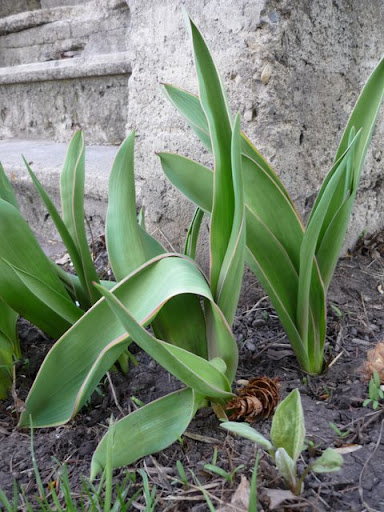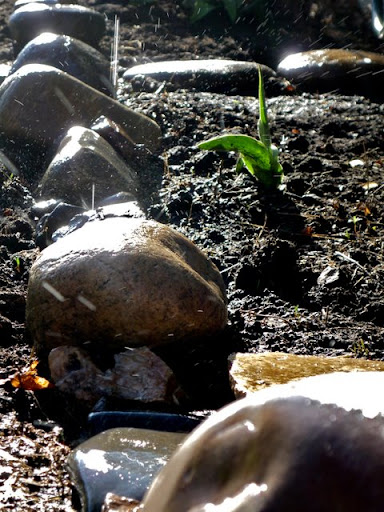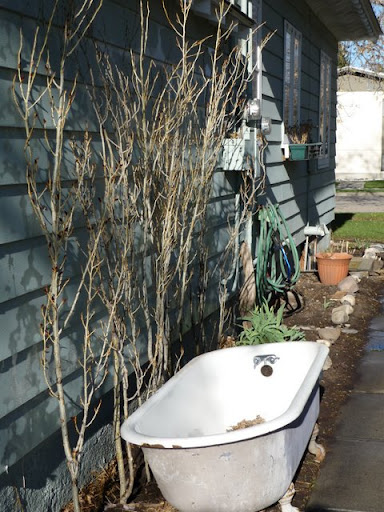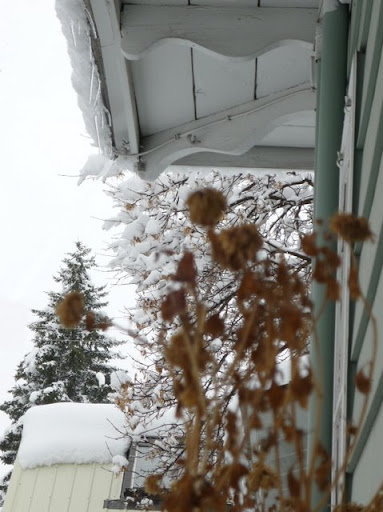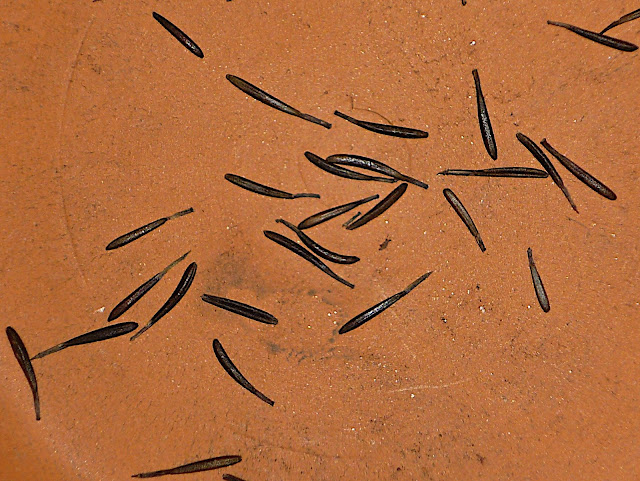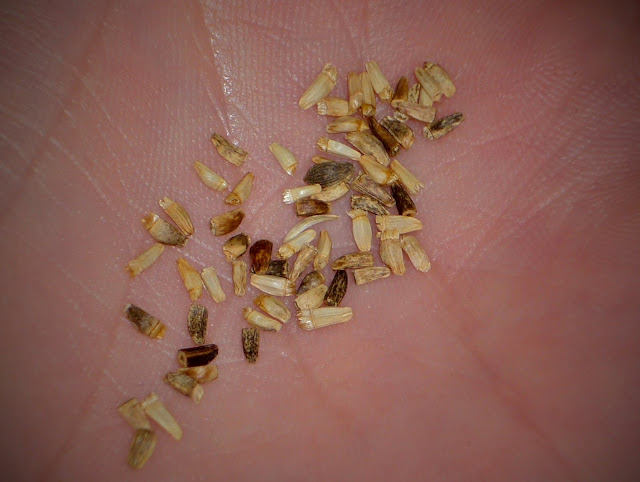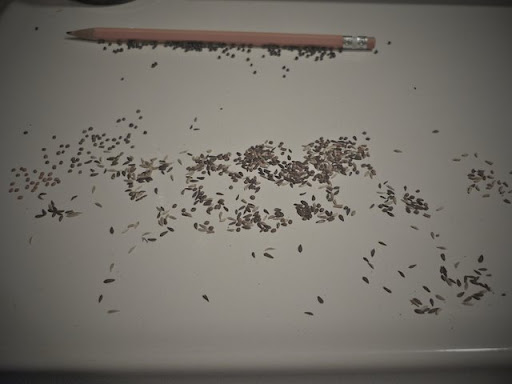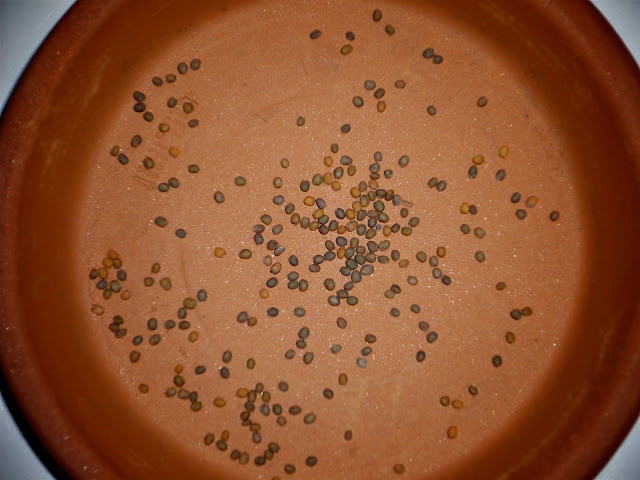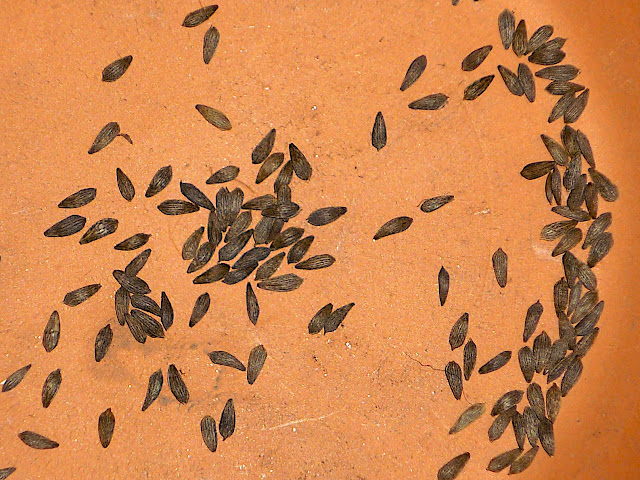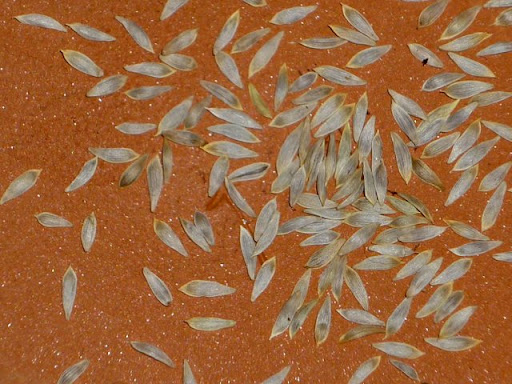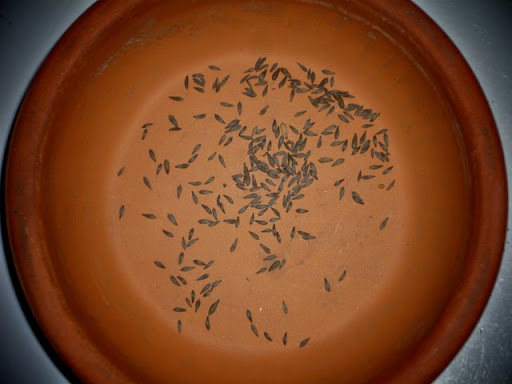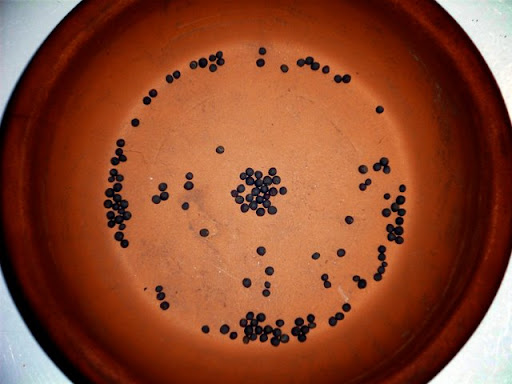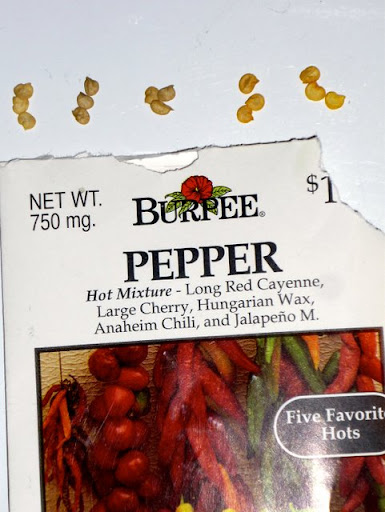Well no, I didn't fall off the face of the planet, just more into the laziness zone. This summer has held successes and failures both personally and in the garden. But thankfully I can learn, and have learned, from them all.
Saturday, October 17, 2009
Hello!
Well no, I didn't fall off the face of the planet, just more into the laziness zone. This summer has held successes and failures both personally and in the garden. But thankfully I can learn, and have learned, from them all.
Sunday, April 26, 2009
Yard Work and Snow
 One afternoon earlier this week I had been outside weeding and moving some rocks for my drip line when I noticed 2 ski patrollers in the yard next door (they moonlight as construction guys during the off season) looking up at some trees. My hopes were high; were they going to chop the trees down or just trim them. These trees are one of our banes of existence in the fall. All of the trees in our yard shed their leaves and we attempt to rake only to have the trees next door drop there leaves the day after, no fail. So I shouted to them to just cut them down and they replied back "were working on it." Oh, happy day.
One afternoon earlier this week I had been outside weeding and moving some rocks for my drip line when I noticed 2 ski patrollers in the yard next door (they moonlight as construction guys during the off season) looking up at some trees. My hopes were high; were they going to chop the trees down or just trim them. These trees are one of our banes of existence in the fall. All of the trees in our yard shed their leaves and we attempt to rake only to have the trees next door drop there leaves the day after, no fail. So I shouted to them to just cut them down and they replied back "were working on it." Oh, happy day. The leaves aren't the only issue with these Lombardy Poplars. A few years ago we had some incredible winds come ripping through town. Several branches came down all over town, but next door one of the branches impaled itself through the roof of the garage! Of course the owner of the place didn't remove it, but just cut it off. We can only assume the branch must have sealed the hole... Last year another of the big branches fell from high up and got caught about half way down. Mason and I have been thinking at least on of the trees was going to come crashing down on to our house. So you can imagine my relief and excitement when I heard they were going to cut them down the next day.
The leaves aren't the only issue with these Lombardy Poplars. A few years ago we had some incredible winds come ripping through town. Several branches came down all over town, but next door one of the branches impaled itself through the roof of the garage! Of course the owner of the place didn't remove it, but just cut it off. We can only assume the branch must have sealed the hole... Last year another of the big branches fell from high up and got caught about half way down. Mason and I have been thinking at least on of the trees was going to come crashing down on to our house. So you can imagine my relief and excitement when I heard they were going to cut them down the next day.Thursday, April 16, 2009
Lettuce Seeds & Sea Urchin Eggs?
 But I didn't mind, it took me back to the days of science labs and I had a flash back to an assignment I had at Occidental College the summer between my junior and senior years of high school. I got to go down to LA to study oceanology for 5 weeks. Monday through Thursday we had class in the morning and a lab afternoon, where we dissected fish or went to the beach and did field research. On Friday we got to spend the day on their 85 foot research boat, The Vantuna. The head professor specialized in invertebrates and one day he used us for some of his research. We had to count how many eggs from a sea urchin there were in one square inch. So we sat at microscopes with hand tally counters and clicked for every egg we saw. Talk about a long time staring at the same thing.
But I didn't mind, it took me back to the days of science labs and I had a flash back to an assignment I had at Occidental College the summer between my junior and senior years of high school. I got to go down to LA to study oceanology for 5 weeks. Monday through Thursday we had class in the morning and a lab afternoon, where we dissected fish or went to the beach and did field research. On Friday we got to spend the day on their 85 foot research boat, The Vantuna. The head professor specialized in invertebrates and one day he used us for some of his research. We had to count how many eggs from a sea urchin there were in one square inch. So we sat at microscopes with hand tally counters and clicked for every egg we saw. Talk about a long time staring at the same thing.Wednesday, April 15, 2009
Snow in the Morning!
 So here in Bozeman we really don't get spring until May, and that is usually mid to late May. So to have a foot plus of snow fall on a mid-April day is almost expected.
So here in Bozeman we really don't get spring until May, and that is usually mid to late May. So to have a foot plus of snow fall on a mid-April day is almost expected. Sunday, April 12, 2009
Failling an Exam and Finding Joy
On Monday morning I went outside to see a great suprise: my flowers were popping up through the dead leaves, soil and snow. What joy those tender little things brought to my heart.
It has been a hard past few weeks. Skiing hard and getting the last few pieces put together for my exam. I had an incredible week on my skis and was just amazed at what I was able to do anywhere on the mountain. I was actually excited for the exam to come and felt ready for whatever would happen, pass or fail. I was just having fun. Thursday morning, the 2nd, came and with some amazing encouragement from my coaches the exam kicked off. The weather was perfect. Snowy, low 20's, fantastic snow; it really couldn't get any better.
The group I was in was great. One other instructor, Alex, was a coworker from Bridger. Maggie, who once worked at Bridger but is currently at Big Sky, was also in our group, as well as Nick, from Big Sky, Dave from Showdown, and Don from Yellowstone Club. Both the examiners were from Big Sky and their shadow, and our great encourager, Karin was from Bridger. All in all, everyone was a strong skier and things went well.
Exams are always hard. There is not nearly as much skiing as we would like. Once we got warmed up the scoring, and waiting, began. We did wedge turns, open parallel, dynamic parallel, and 4 tasks the first day, as well as our bumps demo in seriously low visibility. But the Level III description is "anywhere, anytime, anyplace..." The second day brought our teaching segments, wedge christies and one more task. Overall, things went well. I definitely didn't ski my best, nor did I ski my worst, but I felt I skied well. My teaching segment was by far my best of the year, which was a relief considering that is what I had been most nervous about.
Well by 6 o'clock Friday night the scores were in and I did not pass. It was tough, I cried. But I had nothing to regret. I never quit, I trained hard all year, and I did my best. I was very proud of myself for keeping a great attitude through the entire exam and after (which is what my coaches had felt would be my biggest obstacle). So I truly felt that I had succeeded even though I didn't pass.
In total only 3 people, out of 13, passed the Level III this year. Jen, from Big Sky, as well as Maggie, and my best friend Kate. I am so proud and excited for all three of them.
With little sleep Friday night I attempted to ski Saturday morning. But my body was already giving into the pain and I was home by noon, on the couch, watching TV, sleeping and crying. I unfortunately got the part of the lyrics to a Rascal Flatts song stuck in my head, "What hurts the most, was being so close..." which really didn't help. I ended up staying home and in bed Sunday as well, but by the evening the tears were gone and I was able to right Thank you notes to my coaches and ski school director for everything they did this year in helping me to improve.
Monday morning I finally went outside and that is when I saw them. My flower were coming up. Tulips, narcissus, polemonium, violas, and of course the weeds. So I spent a few hours cleaning out the dead leaves from fall, pulling weeds, and being thankful that I finally have a reason to like the spring and summer. That may sound somewhat strange, but I am a lover of winter, cold weather, and snow. Here in Montana we do have that blessed threesome, but we also have fairly hot summers (and I don't care if you say that it is dry--if it is above 75 it is too hot for me). I also love the dark, and long summer days aren't really that exciting to me. To top it all off I have major depression, and my seasonal affect disorder is opposite of most people: I am happy in the winter and sad in the summer. But now I have something that makes me happy in the summer too: flowers.
The only real problem with this is my inexperience with gardening. I have never grown anything outdoors. I never had a garden in my childhood and I live a few states away from relatives who have amazing outdoor landscapes. But a few years ago I plunged in, and wow am I glad I have a husband who did have a garden growing up. We have a great yard and selected a nice spot for a small vegetable garden. We borrowed a tiller and tilled a nice little 10' x 10' plot, planted a few select veggies, and then began to weed. Had I only known about some of the weeds we had in our yard, maybe I wouldn't have jumped in so fast, but you live and you learn. And now I have a new nemesis: Bindweed, as well as a few other weeds.
Well now I have a few plots of flowers, a small garden, a few containers, and I am still learning about gardening. Hardiness zones, annuals, perennials, corms, bulbs, seeds, germination, and more. Earlier this week I decided to put together a Flower Manual on all the different flowers I had to actually keep track of them all (especially the names of them--scientific or common I had a hard time remembering them all) and I so far have a 37 page document with pictures, hyperlinks, and descriptions of most.
So far it has been great, with the exception that I can only get to it on my desktop computer and the document is slow to load with all the info. Then I realized that it would be a lovely thing to have online, accessible anywhere. So here it is: the adventures of Shannon and her garden...
Friday, April 10, 2009
Portulaca
Helpful Sites
Cilantro
Thursday, April 9, 2009
Lettuce
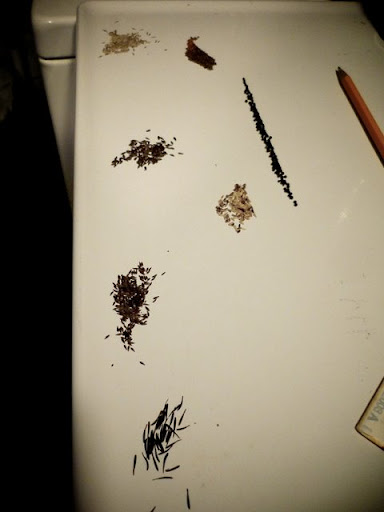 Mesclun Mix
Mesclun Mix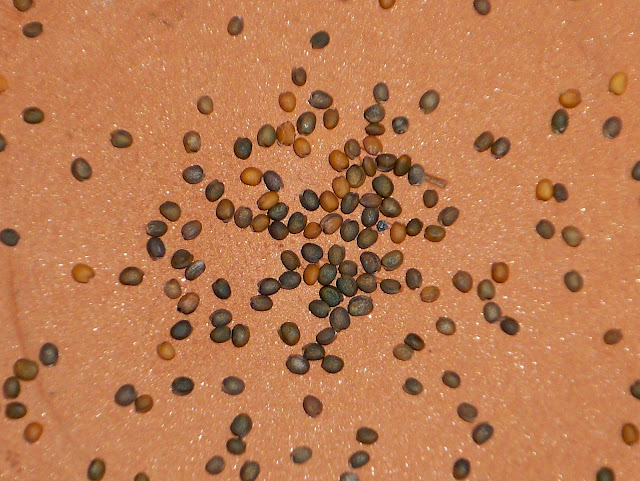 Arugula is an aromatic, peppery salad green. It is also known as roquette, rocket, rugula and rucola, and is very popular in Italian cuisine. It grows wild in Asia and all over the entire Mediterranean --- and has been known to be cultivated and enjoyed in places as exotic as the north of Sudan. In Roman times arugula was grown for both its leaves and the seed. The seed was used for flavoring oils. Arugula has uses beyond salad: it can be sauteed or cooked in many other ways. Don't forget to try arugula sprouts if you get a chance. source
Arugula is an aromatic, peppery salad green. It is also known as roquette, rocket, rugula and rucola, and is very popular in Italian cuisine. It grows wild in Asia and all over the entire Mediterranean --- and has been known to be cultivated and enjoyed in places as exotic as the north of Sudan. In Roman times arugula was grown for both its leaves and the seed. The seed was used for flavoring oils. Arugula has uses beyond salad: it can be sauteed or cooked in many other ways. Don't forget to try arugula sprouts if you get a chance. sourceMajor John Bibb (a veteran of the War of 1812) worked in the backyard of his Frankfort, KY, home to develop what we now know as Bibb lettuce. It found its way into commercial production in the 1930s. Sometimes known as limestone lettuce due to the soil content in Kentucky, it is one of the best known butterhead lettuces along with Boston lettuce. The leaves are loose and delicate with lots of flavor. Nutritionally, it is a good source of Folate and Vitamin A. source
Description - Endive (Cichorium endiva) and chicory Cichorium intybus) are members of the Composite family. Endive has two forms, narrow-leaved endive called curly endive and the broad-leaved endive which is often called escarole. The outside leaves of an endive head are green and bitter. The inner leaves of the endive head are light green to creamy-white and milder flavored. Both types of endive are used in salad mixtures with blander- flavored lettuce to prepare a salad with a "little bite" to the flavor.
Chicory is an important salad vegetable in Europe but not in the U.S. It is most popular in France, Belgium and Holland, In the U.S., chicory is grown for the green leaves which are used as a salad green and for the thick roots which are used in the southern U.S. as an additive flavor to coffee and sometimes as a coffee substitute.
Witloof Chicory (also called French or Belgian Endive) denotes the blanched, tight heads produced by forcing (or growing in the darkness) the big mature chicory roots in forcing structures.
Culture - Endive is grown like lettuce. Seed is sown in early spring in the garden. Plants can be started in the greenhouse and transplanted to the garden for growing and extra early crop. Chicory for greens is grown much the same way. For chicory greens, seed is planted in early spring and the leaves are ready for harvesting in about 60 days. The greens are often blanched by the leaves together when they are about ten inches long. Roots for producing Witloof chicory are grown this way. Seed is planted after danger of frost in the spring. The roots are harvested in the fall before hard freezing occurs. The foliage is removed and the roots are stacked in the field. After they are exposed to cold the roots are planted upright in moist sand and forced to grow a new head by keeping the air temperature near 64 degrees.
Selection - Endive heads should be clean, free of browning, crisp and bright green. Chicory greens resemble Dandelion leaves and should be fresh and free of brown streaks or spots. Young, tender leaves are preferred over older, tougher leaves. Select chicory heads (called chicons) should be pure white, very tight with only the outer two leaves visible. The chicon size for highest grade is at least one inch thick and four and one-half inches long. Endive and chicory greens placed in plastic bags will store in refrigeration for about ten days. Chicory roots should be stored in the refrigerator at 38 to 42o F. and will keep for several months until used or forced to produce chicons. source
Snow in the Summer
Wednesday, April 8, 2009
Chives
When to plant outside: : In early spring, as soon as the soil can be worked, or as late as 2 months before first fall frost.
When to start inside: 6 weeks before average last spring frost.
Special Germination Instructions: Seed requires darkness to germinate. Make sure seed is planted at a depth of ¼” – ½”.
Harvesting: Cut the outer spears of the chives when they are at least 6” long and cut back to 2” above ground. Once or twice a season, shear the plants to 2” above ground. This will keep the new, tender foliage available. The flowers can be harvested when in full bloom. source
Basil
Spinach
Viola
Wooly Thyme
Tuesday, April 7, 2009
Tulips
